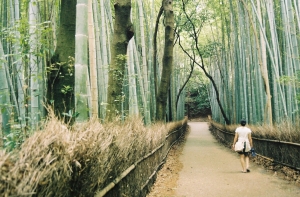The Beijing Forest Forum: Forest Therapy – A Game Changer for Forest Industry?
- 2016-11-25 10:50:00
- admin Original
- 6111
In a country like China, where new ideas spring up everyday and technology and cities grow with unpreceded speed, it is sometimes hard to engage citizens with nature, specifically forests. At the same time an increasing number of people in cities are aware that something is lacking in their life.  The stress of work and family is piling up, while opportunities to slow down and relax are diminishing, often leading to mental disorders like burn-out, depression and just a general lack of meaning in life. In recent years, experts in Japan have realized the huge potential forests could play in healing those new psychological disorders. In Japan, forests are used as a therapy center and forest products as a medicine. This is called “shinrin yoku†or forest therapy. Now in 2016, the idea of this new forest ecosystem service is taking East Asia by storm. This new area of potential use of forests has not been missed by the Beijing Forestry Society either, who organized the biennial event from October 27th to 28th, this year with the theme fittingly being “Forest Therapy†(Chinese: 森林疗养, senlin liaoyang). As forest therapy is a fairly new topic in China, not only experts that are starting pilot projects within China were invited, but also international speakers were significant, including speakers from Japan, Korea and Canada. While to a degree the term is self-explanatory, it also raises a few confusing questions: Is forest therapy just hiking and being in the forest, as it is practiced in the West by many outdoor enthusiasts already? Or is it about eating more forest products with healing properties? The truth is forest therapy is all of these things, but also much more. While the activity of simply being in the forest stands at the core of the practice, the whole approach is much closer related to the professional therapy than our recreational hiking. The original idea was actually not drawn from Japan, who refined it later on, but from the German invention of the “Kurbad†in the 1940s, a therapy center located in natural areas to help patients recover faster by exposing them to the calming effect of nature. The medicinal background was also reflected in the line-up of speakers, which included professionals in the area of medicine and therapy, like Guo Xinbiao (éƒæ–°å½ª) from the Beijing University Hospital or Hao Jinda (éƒè¿‘大 ) from the Traditional Chinese Medicine Resource Center at the Chinese Academy of Sciences. In a word, actual forest therapy requires the patient to actually have a diagnosed mental disorder and prescribes a number of measures that will present the forest therapy program. The therapy center usually lies in the middle of a forest and certified instructors will guide the patients through different activities. These can include everything from barefoot walking on different materials, to sniffing different forest scents, yoga and meditation in the forest. The goal is to reconnect mind and body with nature and slower its rhythm that creates positive health benefits. But what about people that might find their life lacking nature, but have no diagnosed disease? Actually, the Chinese distinguish here between two forms of forest therapy, one being the “forest therapy†described just now, the other being called “forest wellness†(森林康养, senlin kangyang). Forest wellness is less stringent about the kind of treatments the respective person receives, instead offers a multitude of activities, that include most of forest therapy, but also things we would find under “outdoor recreationâ€, for example hiking. While the second area sounds at first less important, it actually caters to a bigger market: specifically China’s old and young. Especially the old, soon to become China’s largest consumer group, provide huge opportunities for the emerging forest wellness industry. The Canadian colleagues Bruce Pendrel and Dana Collins sharing their experiences with forest therapyWhile opportunities are large, actual on the ground experiences with forest therapy are far and few between. The Forest Forum drew from the professional experiences of Kasuga Mihoko from the Yamanashi Health Farm in Japan and Li Shunde from the National Recreation Forest Management Office in Korea. As forest wellness shares many properties with classical outdoor recreation, the Canadian experts Dana Collins, executive director of the Canadian Institute of Forestry and Bruce Pendrel, former director of science at Natural Resources Canada, gave an introduction on the Canadian take on how to relax in forests and which role outdoor recreation plays in Canada.
Establishing a flourishing forest therapy and wellness industry in China, while one of the most promising areas to promote the sustainable use of forests in recent years, remains a challenge and has to be addressed systematically. Dr. Wang Xiaoping, Director of Science and Technology Department of the Beijing Municipal Landscaping Bureau and Secretary General for Beijing Forestry Society, laid out a step-by-step plan for promoting forest therapy in Beijing and other areas in China, including important measurements like working with existing institutions in the area (both forestry and medicine) to establish these centers, working with the government to implement favorable policies, training high quality staff to teach the therapy course and building facilities that will support the experience, be it for traditional forest therapy or forest wellness. Forest therapy and wellness is still in its infancy, however its ability to provide a new and direly needed service to the country is great. Forest therapy might just be the natural answer to China’s mental health .

